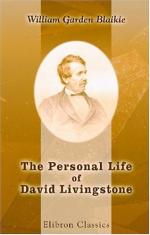* * * * *
No. II.
TREATMENT OF AFRICAN FEVER.
In July, 1859, when the Expedition to the Zambesi had been there about a year. Dr. Livingstone drew up and forwarded to Sir James Clark, Bart., M.D., a very full report on the treatment of African fever. The report details at length a large number of cases, the circumstances under which the attack was experienced, the remedies administered, and their effects. In order to ward off the disease in the mangrove swamps, which were justly described as hotbeds of fever, a dose of quinine was administered daily to each European, amounting to two grains, and taken in sherry wine. When an attack of the disease occurred, and the stomach did not refuse the remedies, Dr. Livingstone administered a dose of calomel with resin of jalap, followed by quinine. These remedies were in almost all cases successful, and the convalescence of the patient was wonderfully rapid. The “pills” which Dr. Livingstone often referred to were composed of resin of jalap, calomel, rhubarb, and quinine. It was usually observed that active employment kept off fever, and that on high lands its attacks were much less violent. Where the stomach refused the remedies a blister was usually the most effectual means of stopping the sickness.
Experience did not confirm the prophylactic action of quinine; exemption from attack in unfavorable situations was rather ascribed to active exercise, good diet, and to absence of damp, exposure to sun, and excessive exertion. Even while navigating an unhealthy part of the Shire, and while, owing to the state of the vessel, the beds were constantly damp, good health was enjoyed, owing to the regular exercise and good fare.
In the upper regions of the Shire, Dr. Livingstone says he and his companions were exposed in the early hours of the morning to the dew from the long grass, marching during the day over rough country under the tropical sun, and then sleeping in the open air; but though they had discontinued the daily use of quinine they Were perfectly well, as were also their native attendants. This was one of the considerations that gave him such confidence in the healthiness of the Shire highlands.
Two or three years later, in writing to a friend, Dr. Livingstone thanked him for having sent him a missionary journal, which he greatly enjoyed—The News of the Churches and Journal of Missions. To show the very unusual pleasure which this Journal gave him, he proposed to send a communication to the editor, but said he was somewhat afraid to do so, lest it should meet the fate of many a paper forwarded to editors at an earlier period of his life. Mustering courage, he did send a letter, and we find it in the number of the journal for August, 1862. It is entitled, “A Note that may be useful to Missionaries in Africa,” and consists of a statement of the remedy for fever, and an account of its operation.




